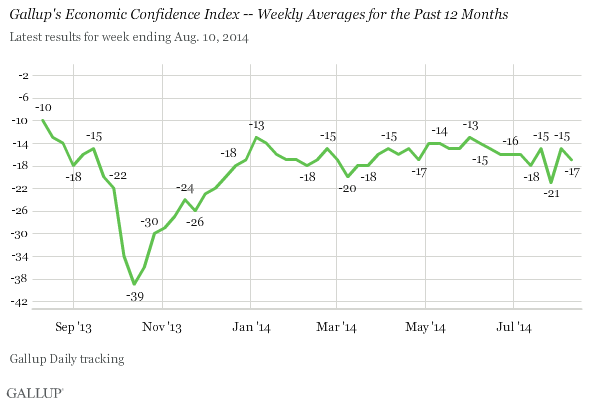WASHINGTON, D.C. -- Gallup's U.S. Economic Confidence Index dropped slightly to -17 for the week ending Aug. 10. Though falling two points from the previous week, the index score is an improvement from the -21 recorded at the end of July, the lowest measure so far in 2014.

Though Gallup's weekly index readings have been remarkably stable so far in 2014, they have shown a bit more variation since July. Week-to-week fluctuations rarely exceeded more than two index points in either direction earlier in 2014, but a six-point drop in July was a brief departure from that stability. The latest reading, however, is a return to the pattern of consistent readings seen so far in 2014.
Gallup's Economic Confidence Index is the average of two components: Americans' views on the current economic situation and their perceptions of whether the economy is getting better or worse. Last week, 19% of Americans said the economy is "excellent" or "good," while 35% said it is "poor," resulting in a current conditions score of -16 -- a three-point dip from the previous week.
While 38% of Americans said the economy is "getting better," 56% said it is "getting worse," resulting in an economic outlook score of -18. This is one point lower than the prior week.

Bottom Line
Economic confidence has been largely stable in 2014 despite some modest week-to-week changes. Generally speaking, Americans remain more negative than positive about the economy, but are less negative than they were in the first few years after the Great Recession.
This year has arguably been a positive one for the economy with growth in consumer spending, the GDP, and hiring, all of which should send the public's economic confidence upward. However, these positive economic developments may be offset by a series of international and domestic challenges, including the rise of Islamic militants in Iraq, intense fighting between the Israelis and Palestinians, increasing U.S.-Russia tensions, a wave of illegal immigrants from Central America, and stock market volatility after a year of steady stock increases in 2013.
Survey Methods
Results for this Gallup poll are based on telephone interviews conducted Aug. 4-10, 2014, on the Gallup Daily tracking survey, with a random sample of 3,035 adults, aged 18 and older, living in all 50 U.S. states and the District of Columbia.
For results based on the total sample of national adults, the margin of sampling error is ±2 percentage points at the 95% confidence level.
Interviews are conducted with respondents on landline telephones and cellular phones, with interviews conducted in Spanish for respondents who are primarily Spanish-speaking. Each sample of national adults includes a minimum quota of 50% cellphone respondents and 50% landline respondents, with additional minimum quotas by time zone within region. Landline and cellular telephone numbers are selected using random-digit-dial methods. Landline respondents are chosen at random within each household on the basis of which member had the most recent birthday.
Samples are weighted to correct for unequal selection probability, nonresponse, and double coverage of landline and cell users in the two sampling frames. They are also weighted to match the national demographics of gender, age, race, Hispanic ethnicity, education, region, population density, and phone status (cellphone only/landline only/both, and cellphone mostly). Demographic weighting targets are based on the most recent Current Population Survey figures for the aged 18 and older U.S. population. Phone status targets are based on the most recent National Health Interview Survey. Population density targets are based on the most recent U.S. census. All reported margins of sampling error include the computed design effects for weighting.
In addition to sampling error, question wording and practical difficulties in conducting surveys can introduce error or bias into the findings of public opinion polls.
For more details on Gallup's polling methodology, visit www.gallup.com.
